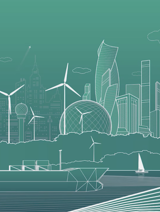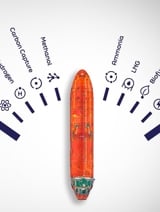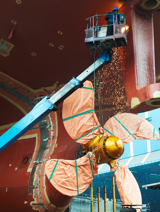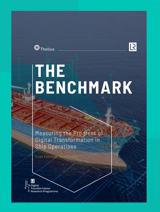The multifunctional battery-powered autonomous workboat, Clearbot, is designed to undertake a range of tasks including floating garbage collection from congested inland and coastal waters, dispersing and skimming floating oil spills, and recovering surface foam.
The rapidly developing technology is potentially suitable for a wide range of other tasks. These include the removal of water hyacinth infestations, bathymetric surveys, cargo deliveries, among many others.
Captain’s Table winner
LR has been carefully tracking the progress of Clearbot, both before and after the robotic vessel start-up was nominated winner of the Captain’s Table competition in 2022.
This annual event, organised by the Young Professionals in Shipping Network, is an accelerator supporting technological startups in the marine sector. Winners benefit from a $30,000 cash prize and £25,000 of free legal advice from global law firm, HFW. LR is an Ecosystem Partner of the competition.
Clearbot co-founder, Sidhant Gupta, explains how the venture began:
“In 2019, me and my co-founder, Utkarsh Goel, were just finishing our undergraduate degrees at the University of Hong Kong and, at that time, the University had a fund that allowed students to travel around and undertake projects. If you had a good project, they would pay for your flights. So we came up with the idea of cleaning up garbage along the beach in Bali.
“We went there and met up with a couple of surf shop owners who would go out very morning to collect garbage by hand. It’s a big problem there because a lot of the local economy depends on the beach being clean. But it’s a massive challenge because they don’t have tools to do this – it’s a manual operation.”
The result was the Clearbot prototype which was designed and built in the hotel and tested in the swimming pool.
“When we started Clearbot, it was all about making a tangible impact,” Utkarsh Goel reflects. “Seeing our bots in action, turning the tide on marine pollution and safer marine services, that's what drives us every day."
Near-shore pollution challenge
Bali has a particular problem for two main reasons. First, ocean currents transfer a lot of floating rubbish from the Indonesian mainland to the island paradise. And second, waste management systems are not effective, so a lot of garbage ends up in sewers and open-water canals that feed into the sea.
Gupta explained that back in Hong Kong, it was clear that near-shore pollution was a major problem there too. In fact, it is endemic in virtually every coastal city. In Hong Kong, they were using three-person petrol and diesel boats to collect garbage from the water. But in carbon terms, the process actually created more pollution than the garbage that was cleaned up. Plus, the procedure was expensive, using large volumes of fuel and lots of human resources.
“So we created something that was electric, autonomous and better for the environment,” said Gupta, “That’s how we started!”
The bots employ AI for post processing and analysis of the garbage collected. For navigation, the bots utilise lidar and other sensors to map the marine environment.
In the early days, fixing appropriate insurance arrangements proved a challenge. However, the 2022 Captain’s Table win proved to be a catalyst as the Clearbot project caught the attention of the Shipowners’ Club, a London-based mutual insurer. The Club is now providing insurance cover in support of Clearbot’s current fleet expansion.
Rapid expansion
The young venture is growing rapidly. It has gone from one bot to 11 and has now embarked on the next phase of up to 100 units.
The company was close to break-even in 2022-23, but its ambitious growth strategy will soon require another round of funding. Gupta acknowledges the challenge: with any young venture, he says, it’s a balance between growth and profitability.
By April this year, the company will have at least three bots working in India where some remarkable projects have already been undertaken. At Umiam Lake, for example, which is located close to Shillong, Meghalaya, and empties into the Bay of Bengal, garbage covers its entire surface so that no water is visible. Yet local people still eat the fish from the lake.
It became evident that the scale of the task required larger units and that is now a key objective of Clearbot’s technical personnel. So, bot development, both in terms of size and cargo disposal, is developing fast.
The latest bots, in the process of being certified by LR, are much bigger. Rather than clearing 80 kgs of garbage per hour with the smaller model, the team are now targeting 200 kgs per hour with the larger ones.
As multifunctional units, the bots are completely modular and can be converted from one operation to another in less than an hour. Cargo deliveries are high on the agenda: in many locations, drones are now used to deliver cargo consignments to remote locations – a hotel on an island, for example.
But drones are limited to payloads of 15-20kgs. A bot could ship consignments at least 20 times larger over longer distances.
The Clearbot team have countless ideas about new opportunities for their unique technology in many parts of the world. Access to capital is still a limiting factor but Gupta and his colleagues do not see this as a long-term constraint. They reveal that their business model is clearly seen as sufficiently robust by some early clients who have expressed a wish to buy into the venture.
Find out more at:








